Mountain School is ON!: Playing in the Snow, Compensating for the Government Shutdown
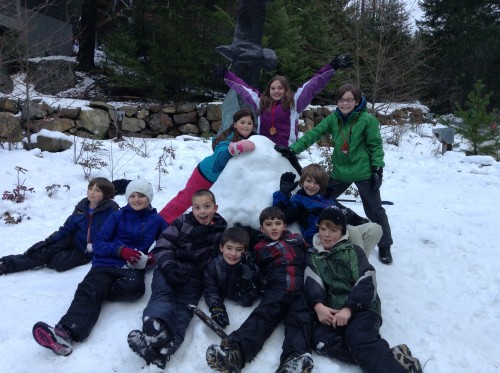
Columbia Elementary School was already told once they couldn’t come to Mountain School as planned. So they certainly weren’t going to let the biggest local snowstorm of the year so far stop them from enjoying a second chance to learn about ecology, carnivores, and community during their rescheduled visit last week.
During this past October’s government shutdown, four of the North Cascade Institute’s Mountain School sessions had to be cancelled because the Institute is in a national park and all federal operations were mandated to close. Over 250 fifth graders from Bellingham were told they couldn’t have their seminal 5th grade experience in the wilderness as expected. Some teachers, including Columbia’s, wisely used this misfortune as a teachable moment, organizing students to write letters to their local representatives expressing their discontent. Though the government “re-opened” after 16 days, and the Institute was able to make up one of these cancelled schools by extending its fall season by one session, what about the rest of the students?
The answer? Spring season. Mountain School started three weeks early this year.
It was, however, nearly a false start.
Columbia’s estimated time of arrival was late morning, weather depending. Nine graduate students, four new seasonal naturalists, two staff naturalists, the Mountain School Program Coordinator, and the rest of the Environmental Learning Center community were eager to meet the 83 4th and 5th grade students. But the snow started to fall heavily around Newhalem, eight miles west of the Learning Center and the beginning of a stretch of road prone to rock fall and avalanches. The two yellow school buses were parked. Students built snowmen. The adults deliberated. Mountain School representatives traveled down Highway 20 to meet them and assess possible options. Would the buses be able to drive safely down the hill toward the road atop Diablo Dam?
After much consideration and lunch, they decided that yes, the buses would make it. Mountain School or bust! Columbia Elementary arrived successfully at the Environmental Learning Center in the early afternoon. Most of the instructors had not taught in the snow before. And as the snow became rain, the white trails turned to muddy slush, making for a challenging start. Luckily we had plenty of Mountain School gear (much of it donated) to augment the students’ clothing.
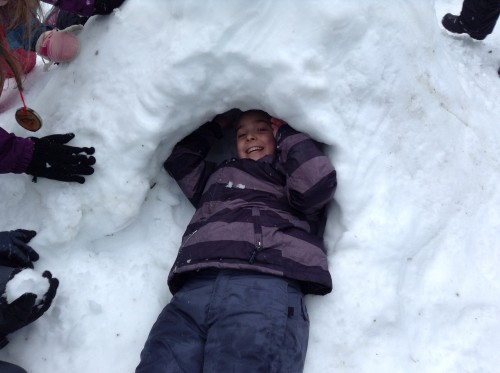 Not your everyday lesson: Students learn to build a snow shelter. Photo by Rebecca Wiederhold.
Not your everyday lesson: Students learn to build a snow shelter. Photo by Rebecca Wiederhold.
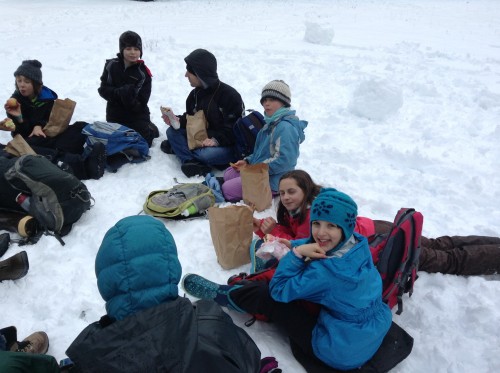 Lunchtime smiles. Photo by Rebecca Wiederhold.
Lunchtime smiles. Photo by Rebecca Wiederhold.
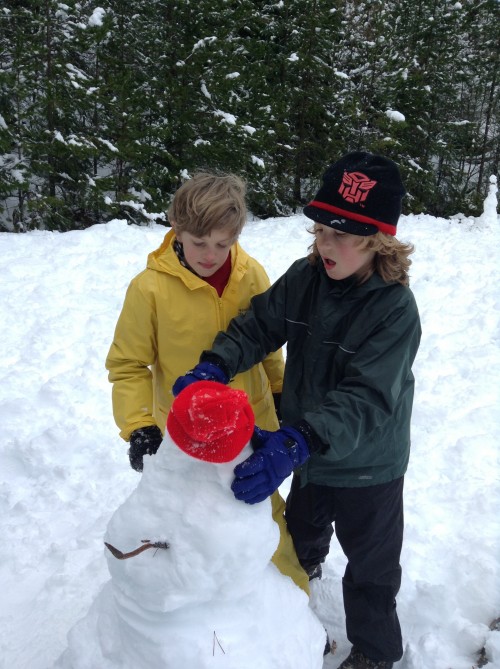 One of many snow-folk that popped up around the Environmental Learning Center. Photo by Rebecca Wiederhold.
One of many snow-folk that popped up around the Environmental Learning Center. Photo by Rebecca Wiederhold.
Day two is our longest, all-day stretch in the field. This time, the temperature fell by a few degrees, and the previous day’s raindrops transitioned, fortunately, back into snowflakes. These eight hours highlighted one of the characteristics for which experiential educators are best known: Flexibility! Instead of proceeding with our lessons as planned, many of us delved into snow science, how to build snow shelters, and making “real” glaciers through layers and layers of compacted snow. Building snowmen became a popular team-building exercise. Friendly snowball fights were irresistible, becoming a mandatory component of everyone’s day. A lesson on animal signs was improved from the normal discussion by the opportunity to make various animals’ tracks in the snow. Most trail groups stayed closer to campus than usual, warming up every couple of hours with new, dry gear and hot chocolate courtesy of Chef Shelby. Transitioning from an outdoor-based curriculum to the necessity of more classroom time was a bit challenging for several instructors, since one of the main opportunities of Mountain School is to get these students out in the fresh air, beyond the four walls of their typical educational experience and honing their observation skills in nature. But the students didn’t seem to mind, for the most part, and it was a good exercise for the instructors to consider what lessons and games would transfer well to the indoors.
Despite such issues, the students had a memorable and unique three days at Mountain School. As they got ready to get back on their school buses, I don’t think I’ve ever had so many of them say they wish they could stay here instead of going home. Having “school” in the national park is always a different experience than being in a classroom down valley, of course, but the addition of snow made it something magical. Because really, how more “mountain” can you get than falling snow?
 A student gets a better look at a bird. Photo by Rebecca Wiederhold.
A student gets a better look at a bird. Photo by Rebecca Wiederhold.
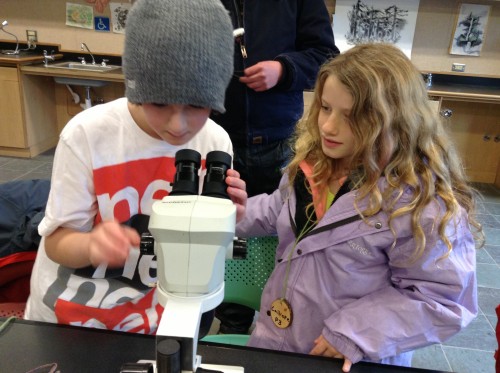 And when the weather gets too bad, or the students need to warm up, there are the indoor classrooms. Microscopes are always a hit. Photo by Rebecca Wiederhold.
And when the weather gets too bad, or the students need to warm up, there are the indoor classrooms. Microscopes are always a hit. Photo by Rebecca Wiederhold.
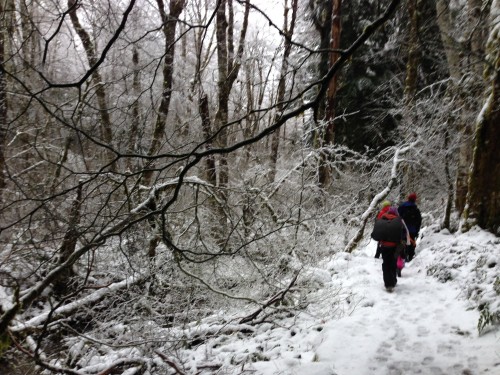 It’s a different forest, and a different teaching opportunity, when covered in snow. Photo by Shannon Sampson.
It’s a different forest, and a different teaching opportunity, when covered in snow. Photo by Shannon Sampson.
Leading photo: Students LOVE the snow! This trail group poses, beaming, in front of their small snow shelter. Photo by Rebecca Wiederhold.
Katherine Renz is a graduate student in North Cascades Institute and Western Washington University’s M.Ed. program and co-editor of Chattermarks. She is looking forward to the upcoming transition from “primarily grad student” to “mostly Mountain School instructor”.

